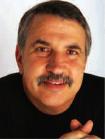 Thomas Friedman is now doubtful that China will follow an American lead towards a greener economy, as he suggested in his book Hot, Flat and Crowded reviewed here. He considers rather that it is more likely to pull ahead of the US. He writes from China in his recent column in the New York Timesthat he’s been astonished to learn of how many projects have got under way in China in just the last year –- wind, solar, nuclear, mass transit and more efficient coal burning.
Thomas Friedman is now doubtful that China will follow an American lead towards a greener economy, as he suggested in his book Hot, Flat and Crowded reviewed here. He considers rather that it is more likely to pull ahead of the US. He writes from China in his recent column in the New York Timesthat he’s been astonished to learn of how many projects have got under way in China in just the last year –- wind, solar, nuclear, mass transit and more efficient coal burning.
He quotes Bill Gross, head of a solar-thermal Californian company, eSolar, announcing the biggest solar deal ever, a 2 gigawatt, $5 billion deal to build solar thermal plants in China using California-based technology. Gross comments that China is being more aggressive than the US. His company applied for a US Department of Energy loan for a 92 megawatt project in New Mexico. In less time than it took them to do stage 1 of the application review “China signs, approves, and is ready to begin construction this year on a 20 times bigger project!”
Friedman goes on to instance other developments. Solar panels are one. He says so many new solar panel makers emerged in China in the last year alone that the price of solar power has fallen from roughly 59 cents a kilowatt hour to 16 cents. 50 new nuclear reactors are expected to be built by 2020, while the rest of the world may manage 15. High speed trains are breaking world records. A high speed rail link from Shanghai to Beijing means trains will cover the 700 miles in just five hours, compared with 12 hours today (and 18 hours for a similar distance from New York to Chicago in the US).
China is on the way to making green power technologies cheaper for itself and for everyone else.
“But even Chinese experts will tell you that it will all happen faster and more effectively if China and America work together — with the U.S. specializing in energy research and innovation, at which China is still weak, as well as in venture investing and servicing of new clean technologies, and with China specializing in mass production.”
Friedman concludes with a call to America to put in place a long-term carbon price that stimulates and rewards clean power innovation. “We can’t afford to be asleep with an invigorated China wide awake.”
Meanwhile India has plans to be a world leader in solar power, as announced by the Prime Minister a couple of days ago. He launched the National Solar Mission with a target of 20,000 megawatts of solar generating capacity by 2022. It will be helped along by a regulatory and incentive framework. Manmohan Singh hoped the new laws and incentives will “lead to a rapid scale up of capacity. This will encourage technological innovation and generate economies of scale, thereby leading to a steady lowering of costs. Once parity with conventional power tariff is achieved, there will be no technological or economic constraint to the rapid and large-scale expansion of solar power thereafter”.
He said he was “convinced that solar energy can also be the next scientific and technological frontier in India after atomic energy, space and information technology”. The scheme has pride of place in India’s National Action Plan on Climate Change.
